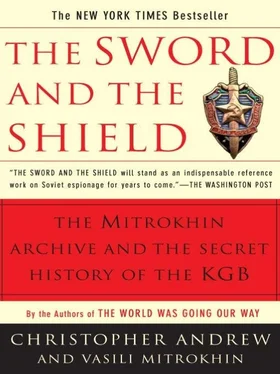Subject Quebec. Sources advise that urgent action be taken to temporarily break contact with the FLQ militants since the Canadian government’s measures may have undesirable consequences.
Questions followed in the Canadian parliament. Prime Minister Pierre Trudeau declared that if the CIA was operating in Canada, it was “without the knowledge or consent of the government.” 26Twenty years later the forged memorandum was still being quoted in Canadian publications, even by some academic authorities. 27Further forgeries suggesting CIA involvement with Quebec extremists were circulated on the eve of the visit to Canada by President Nixon in 1972. 28
ANDROPOV’S FRUSTRATION AT the difficulty of mounting peacetime special tasks which would leave no trace of the KGB’s involvement was heightened by his mistaken conviction that the CIA was pursuing its own series of special tasks against KGB officers and other Soviet citizens living abroad. In a letter to Brezhnev of May 21, 1970, headed “of special importance,” Andropov gave three instances of actual or attempted “abductions” by the CIA: the unsuccessful attempt to abduct the KGB officer Georgi Petrovich Pokrovsky in Tokyo on March 17, 1966; similarly, Yuri Sergeevich Pivovarov of the GRU in Buenos Aires on March 29, 1970; and the disappearance without trace of a Novosti correspondent in Delhi, Yuri Aleksandrovich Bezmenov, on March 9, 1970. 29
Andropov’s allegations derived not from any real CIA program of covert action but from his own addiction to conspiracy theory. Pivovarov had been the victim of an attempted kidnap and assassination by the right-wing Argentinian terrorist group Mano (“Hand”), which claimed to be avenging the kidnapping of a Paraguayan diplomat by left-wing terrorists. 30Most other cases of alleged CIA special actions against KGB officers were in reality cases of actual or attempted defection. Some FCD officers realized—as Andropov did not—that “abductions” were convenient fictions used by residencies to conceal the shameful reality of defection. Such was the case, for example, in the disappearance of Bezmenov. Anxious to save face, the Delhi residency had reported that he had been abducted, and his son (the closest surviving relative) was given financial compensation. 31In reality, as Bezmenov later admitted:
I decided to stay in India to become a kind of hippie and get to now the country. Unfortunately, I started reading local newspaper and found out the Indian police were looking for me. I panicked. I tried to make a deal with smugglers to take me out of the country, but they either wanted too much money or didn’t trust me.
Eventually Bezmenov approached the CIA, who exfiltrated him first to Greece, where he was debriefed, then resettled him in Canada. 32The KGB abandoned the myth of Bezmenov’s abduction after he was seen visiting an exhibition in Montreal in 1974, and ordered his bewildered son to return all the money they had paid to him. 33
The conspiracy theorists in the Centre, however, remained convinced that the CIA was out to abduct KGB officers, as well as to induce them “to commit treason” (in other words, to defect). That belief survived until the end of the Cold War. When Kryuchkov became the first head of the FCD to visit Washington in 1987, Robert Gates, then deputy DCI, found it impossible to persuade him that a Soviet scientist, Vladimir Valentinovich Aleksandrov, who had gone missing in Spain, had not been physically abducted by the CIA. 34
In his letter to Brezhnev of May 21, 1970, Andropov insisted that the CIA dared to engage in “brazen” provocations towards the KGB only because of “the lack of appropriate measures on our part.” It was, he argued, high time to retaliate in kind and abduct a CIA officer to teach the Americans a lesson. To avoid the risk that a KGB special action might go wrong and become publicly known, Andropov asked Brezhnev’s permission to use a proxy.
The precedent set by the previous use of Sandinista guerrillas against American targets in central and north America. 35encouraged both Andropov and Department V to consider the use of Palestinian terrorists as proxies in the Middle East and Europe. The man chiefly responsible for exporting Palestinian terrorism to Europe was Dr Wadi Haddad, deputy leader of the Marxist-Leninist Popular Front for the Liberation of Palestine (PFLP), headed by Dr George Habash. In 1968-9 Haddad had attracted favorable attention in the Centre with a spate of aircraft hijackings and attacks on Israeli offices and Jewish businesses in European capitals. In 1970 he was recruited by the KGB as agent NATSIONALIST. Andropov reported to Brezhnev:
The nature of our relations with W. Haddad enables us to control the external operations of the PFLP to a certain degree, to exert influence in a manner favorable to the Soviet Union and also to carry out active measures in support of our interests through the organization’s assets while observing the necessary conspiratorial secrecy. 36
Andropov sought Brezhnev’s approval to use Haddad for a special action against the CIA:
It appears expedient to carry out an operation to abduct the deputy CIA resident in Lebanon… and to have him taken to the Soviet Union both as a retaliatory measure and with the aim of possibly obtaining reliable information [from him] about the plans and specific operations of the USA in the Middle East. It is planned to carry out the operation through a reliable agent of the Beirut residency, NATSIONALIST [Haddad], who directs the sabotage operations of the Popular Front for the Liberation of Palestine and is experienced in carrying out aggressive measures.
The essence of the operational plan is that [the CIA officer] would be abducted by NATSIONALIST’s reliable fighters in Beirut or its surroundings and would be delivered illicitly to a place which we selected in the Damascus region, where he would be handed over to our operational officers. From Damascus, he would be taken illegally to the USSR on one of our special aircraft or on board ship.
Bearing in mind that the Palestinian guerrilla organizations have recently stepped up their activities in Lebanon against American intelligence and its agents, the Lebanese authorities and the Americans would suspect Palestinian guerrillas of carrying out the above operation. The ultimate purpose of the operation would be known only to NATSIONALIST, on the foreign side, and to the KGB officers directly involved in planning the operation and carrying it out, on the Soviet side.
I request your authority to prepare and carry out the above operation.
Brezhnev gave his consent on May 25, 1970. The Beirut residency then passed on to Haddad a detailed dossier on the CIA officer (codenamed VIR), his home address (a fourth-floor apartment), car (a light blue Ford Comet with diplomatic numberplates), route to and from work at the US embassy and personal habits. It was noted, for example, that VIR regularly went for walks accompanied by his black poodle.
Haddad agreed to select three of the “most experienced and reliable” gunmen to kidnap VIR. As soon as he had been seized, his captors would press over his mouth and nose a mask impregnated with a general anaesthetic supplied by Department V. While VIR was unconscious, he would be given an injection (also provided by the KGB) which would leave him disoriented and unable to resist when he recovered consciousness. The PFLP would then drive VIR, dressed in fedayeen clothes, into Syria along a route carefully reconnoitered by the KGB and hand him over to Line F officers from the Damascus residency in a hamlet near Zabadani. From there he was to be exfiltrated by the KGB to the Soviet Union. 37
One of Haddad’s probable reasons for agreeing to work as a Soviet agent was to obtain arms for the PFLP. In July 1970 Brezhnev agreed to an initial request from Andropov that Haddad be supplied from the KGB arsenal with five RPG-7 handheld anti-tank grenade launchers for terrorist operations. The head of Department V, Nikolai Pavlovich Gusev, and his assistant, Aleksei Nikolayevich Savin, then met Haddad to discuss the handover of further arms supplies which it was agreed to deliver under cover to darkness in an inflatable rubber boat at a pre-arranged spot near Aden. Control of the operation, codenamed VOSTOK (“East”), was entrusted to the deputy head (later head) of Department V, Aleksandr Ivanovich Lazarenko. On the orders of the defense minister, Marshal Ustinov, the arms for Haddad were loaded on an intelligence-gathering vessel of the Pacific Fleet, the Kursograf, at Vladivostok. With S. M. Grankin from Department V on board to supervise the handover, the Kursograf then set sail for the gulf of Aden to rendezvous with Haddad’s motor launch at a point 12°34′ north and 45°12′ east, at 2100 hours local time. As arranged, Haddad signaled his presence with a 360-degree red signal light. The Kursograf extinguished its lights, locked on to the launch’s radio beacon and signaled its presence with two brief flashes, repeated after a short interval. On receiving the answering signal (four brief flashes) from Haddad, the Kursograf launched the rubber boat containing the arms supplies and gave the agreed signal “Load launched” (three brief flashes) twice. Haddad’s launch gave the same signal in reply, then made a “dot-dash” signal twice as soon as it had picked up the arms.
Читать дальше











